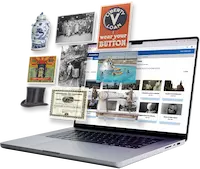Creating Effective Archival Finding Aids: Tips for Writing Clear Descriptions

Margot Note
Archival finding aids are the primary tool for guiding researchers through the contents of a collection, helping them understand what is available and how to use it. Writing clear and concise descriptions is essential for creating archival finding aids that are accessible, engaging, and informative.
The Importance of Well-Crafted Finding Aids
The language used in archival descriptions has a direct impact on user experience. Descriptions help users quickly assess whether a collection is relevant to their research, while poorly structured or verbose descriptions can lead to confusion and frustration. Thoughtful language choices also contribute to the inclusivity of archival descriptions, ensuring they are accessible to a wide range of users, regardless of their background or expertise.
Additionally, well-crafted descriptions can influence how collections are perceived and valued. Descriptions that emphasize the significance and research potential of materials can attract a wider audience and encourage deeper engagement with the collection.
Best Practices for Creating Archival Finding Aid Descriptions
Archival descriptions should be written with the user in mind, presenting information in a way that is easy to understand and navigate. Clear descriptions reduce barriers to archival access, making it easier for researchers to identify relevant materials and assess their usefulness. Concise descriptions help prevent information overload, enabling users to grasp the content and context without sifting through lengthy text.
By focusing on clarity, consistency, and context, archivists can create descriptions that enhance the user experience, support discoverability, and provide meaningful insights into the significance of collections.
To ensure clarity, archivists should follow best practices for archival descriptions, including:
- Using controlled vocabulary
- Avoiding jargon
- Crafting compelling scope and content notes
6 Writing Tips for Finding Aid Descriptions
Effective archival descriptions can make collections more discoverable in online catalogs and databases. The language choices made in descriptions can affect how materials are indexed, retrieved, and displayed in search results—directly influencing a researcher’s ability to find and use resources.
1. Use a Controlled Vocabulary
Creating accessible and engaging archival descriptions requires careful attention to language, structure, and content. Controlled vocabularies, such as the Library of Congress Subject Headings (LCSH) or the Art & Architecture Thesaurus (AAT), provide predefined terms that ensure consistency in how collections are described. By using a controlled vocabulary, archivists can improve indexing and retrieval while maintaining uniformity across descriptions.
Standardized terminology helps users navigate collections more effectively by reducing ambiguity and enhancing searchability. For example, using “correspondence” instead of variations like “letters” or “communications” ensures that similar materials are described consistently across collections, making them easier to find.
2. Limit Jargon and Specialized Terms
While archivists are familiar with the specialized language of their profession, many researchers may not be. Avoiding jargon and overly technical language ensures descriptions are accessible to a broader audience, including those unfamiliar with archival terminology.
For instance, instead of using “provenance” or “fonds,” which may be unclear to some users, consider more straightforward terms like “origin” or “collection.” If specialized terms must be used, define them within the description. This helps make the finding aid more approachable and understandable.
3. Provide Descriptive Scope and Content Notes
Scope and content notes are key elements of archival descriptions that provide users with an overview of the types of materials present, their subject matter, and their significance. To write effective scope and content notes, focus on describing what the materials are about and why they are important.
For example, rather than stating, “This series contains correspondence,” a more informative scope and content note would be: “This series contains correspondence between environmental activists and government officials, documenting efforts to regulate pollution in the region from 1975 to 1985.” This additional context helps users understand the research value of the materials and their relevance to specific topics or themes.
4. Avoid Unnecessary Embellishments
Writing concise descriptions does not mean leaving out important details. Aim to balance brevity and informativeness by including essential information without unnecessary embellishments. Break down complex ideas into more straightforward statements and focus on the main aspects of the collection.
For example, instead of writing, “This collection, which was acquired in multiple stages and comprised a diverse array of materials reflecting the broad interests and extensive professional endeavors of the creator over several decades, contains correspondence, reports, and photographs,” consider: “This collection includes correspondence, reports, and photographs documenting the creator’s professional activities and interests from the 1950s to the 1990s.”
5. Write in Active Voice
Using an active voice helps create direct and engaging descriptions. It can make the narrative more dynamic and easier to follow. For example, instead of writing, “Materials were compiled by the creator,” use “The creator compiled these materials.” This subtle shift makes the description more readable.
6. Include Contextual Information
Providing context about the subject matter or creator’s background can significantly enhance a finding aid’s value. This contextual information helps users understand the materials’ significance and see how they relate to broader historical, cultural, or social themes.
For example, archivists can describe newspaper clippings thusly: “This series of clippings, collected by journalist Jane Doe, documents political events in the 1960s, focusing on civil rights activism and legislative reforms.” Such descriptions convey what is in the collection and highlight its research potential.
Finding Aids Should Enhance the User Experience and Encourage Exploration
Writing clear and concise descriptions for archival finding aids is an art and a science. By using controlled vocabulary, avoiding jargon, constructing informative scope and content notes, and choosing descriptive language thoughtfully, archivists can create finding aids that are not only accessible and engaging but also supportive of discovery and research.
These best practices enhance the user experience, ensuring that archival materials are presented in a way that unlocks their full potential for exploration and analysis.

Margot Note
Margot Note, archivist, consultant, and Lucidea Press author, is a frequent blogger and popular webinar presenter for Lucidea—provider of ArchivEra, archival collections management software for today’s challenges and tomorrow’s opportunities. Download a free copy of Margot’s latest book, The Archivists’ Advantage: Choosing the Right Collections Management System, and explore more of her content here.
Never miss another post. Subscribe today!
Similar Posts
Balancing Collection- and
Item-Level Information in Archival Description
How much detail is enough when describing an archival collection? Finding the right balance between broad overviews and detailed item descriptions ensures accessibility research efficiency and proper context for archival materials.
Best Practices in Archival Description
Standards like ISAD(G) DACS and EAD guide archivists in creating clear consistent descriptions for easier access. Learn more about each of these frameworks and how they enhance visibility and research.
Practical Strategies for Arranging Mixed-Media Archives
Managing and arranging mixed-media archives requires balancing the unique needs of physical and digital records. Discover best practices for metadata organizational structures and cross-referencing to ensure seamless access and long-term preservation.
Arranging Digital Archives: 4 Unique Challenges for Modern Archivists
Arranging digital archives comes with unique challenges requiring new strategies to preserve context manage volume and ensure long-term access. How can archivists adapt to safeguard digital heritage?







Leave a Comment
Comments are reviewed and must adhere to our comments policy.
0 Comments